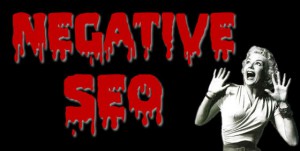 Most of us with a website are aware of the term SEO, AKA Search Engine Optimisation – the “stuff” that you have to do to, and with, your website in order to appear as high up in the Search Engine Results Pages (SERPs) as possible, and ideally on Page 1.
Most of us with a website are aware of the term SEO, AKA Search Engine Optimisation – the “stuff” that you have to do to, and with, your website in order to appear as high up in the Search Engine Results Pages (SERPs) as possible, and ideally on Page 1.
In fact SEO forms a major part of my business – helping your business be easily found online.
What you might not be so familiar with is “Negative SEO” but you should be – Negative SEO is something that your competitors could do to your website, and the worst case scenario is that your site is deleted from Google’s database which would make your internet presence virtually invisible.
So, what is “negative SEO”?
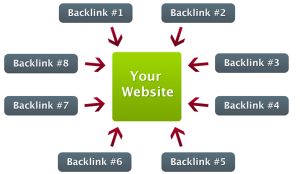 One of key ways that Google judges the importance of your website, and where it appears on the SERPs, is based on the number of websites that link to your site and the quality of those originating sites that have published the links.
One of key ways that Google judges the importance of your website, and where it appears on the SERPs, is based on the number of websites that link to your site and the quality of those originating sites that have published the links.
In a simplistic way, Google sees each link as a “vote” for your site and the more “votes” you have, the more popular your site must be and so it must be deserving of a higher position on Google’s results pages.
However, if any of these links come from sites that are of poor quality, are totally irrelevant or Google doesn’t like then Google will apply a penalty to your site.
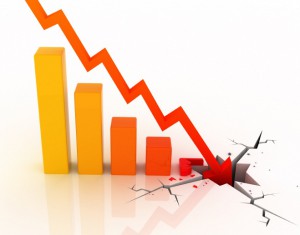 A minor indiscretion could see any changes to your site ignored by Google, meaning that your site will slowly drift down the results as other businesses improve their sites.
A minor indiscretion could see any changes to your site ignored by Google, meaning that your site will slowly drift down the results as other businesses improve their sites.
An “intermediate” issue could see Google apply an active penalty – pushing your site down by 5 pages or more.
For something far more serious, such as buying links from a Link Farm (a website that sells nothing but links purely for the purpose of improving your search results) is likely to see your website deleted from Google – buying links in general, and buying from a Link Farm specifically are SEO tactics that Google simply hates.
How do I know whether I’ve been penalised
There are two key ways to know whether you’ve been penalised – the “Locking the stable door after the horse has bolted” method is simply the realisation that the inquiries that you had become used to receiving from your site have dwindled away to nothing, or that you can no longer find your website in the Google results – no matter how many results pages you look at.
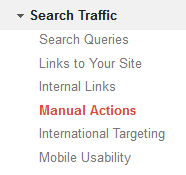 This is too late, the smarter site owner/manager will be regularly logging in to the Google Webmaster Toolkit to check, among other things, the “Manual Actions” tab that can be found in the “Search Traffic” section. This is where Google will post notifications of any forthcoming penalties and also provides an opportunity for the site owner to take action and notify Google of that action
This is too late, the smarter site owner/manager will be regularly logging in to the Google Webmaster Toolkit to check, among other things, the “Manual Actions” tab that can be found in the “Search Traffic” section. This is where Google will post notifications of any forthcoming penalties and also provides an opportunity for the site owner to take action and notify Google of that action
What should I be doing?
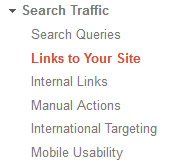 The smart website owner will be regularly logging in to their Google Webmaster Toolkit and will be keeping an eye on the latest links report that can be found by navigating to “Search Traffic/Links to your Site”, clicking on the “More” option in the “Who links most” section and downloading the “Latest Links” to make sure that there’s nothing that they are unhappy with.
The smart website owner will be regularly logging in to their Google Webmaster Toolkit and will be keeping an eye on the latest links report that can be found by navigating to “Search Traffic/Links to your Site”, clicking on the “More” option in the “Who links most” section and downloading the “Latest Links” to make sure that there’s nothing that they are unhappy with.
To be extra safe, they’ll also carry out a full Link Audit using the full list of sites which have back-links leading to their site, contacting any that are suspicious looking and asking for them to be removed. In Google Land it’s far far better to have fewer high quality links than loads of low quality links.
Alternatively, you can drop me an email, andy@enterprise-oms.co.uk or give me a call on 01793 238020 and I’ll lift all of the worry of Negative SEO from your shoulders.





